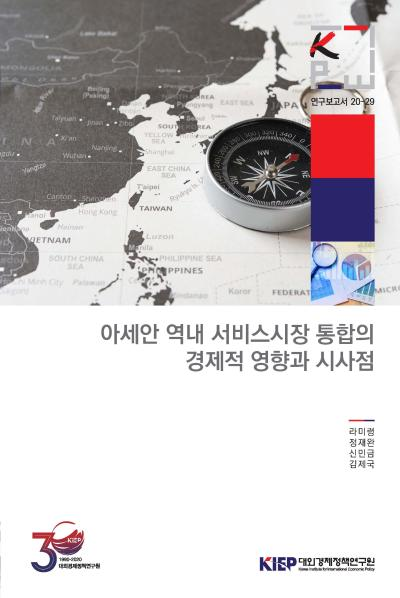Policy Analyses
Publications
Policy Analyses
To list

ASEAN Economic Integration on Services: An Analysis of Economic Impacts and Implications
economic integration, trade policy
Author Meeryung La, Jaewan Cheong, Mingeum Shin, and Jegook Kim Series 20-29 Language Korean Date 2020.12.30
ASEAN has been pursuing economic integration on services since 1995, reducing trade restrictions on services to ASEAN member states through the ASEAN Framework Agreement on Services (AFAS) packages commitments. ASEAN signed the ASEAN Trade in Services Agreement (ATISA) on October 2020, which includes built-in agenda to convert members’ commitments to a negative approach, replacing the AFAS 10th package. Upon this backdrop, this report aims to analyze the current status of economic integration on services among ASEAN members and the impact of such commitments on ASEAN and non-ASEAN countries.
The targets of AFAS packages are summarized as follows: (i) eliminating Mode 1 and 2 restrictions, (ii) substantially eliminating market access limitations regarding Mode 3, and (iii) raising minimum ASEAN equity participation to 70%. Upon reviewing the commitments concluded in the AFAS 10th package, Myanmar, the Philippines and Viet Nam were yet to reach the thresholds, and the overall degree of openness among ASEAN member states regarding Mode 3 restrictions remained relatively low.
Meanwhile, ASEAN has restricted liberalization on the movement of natural persons (Mode 4), and signed the ASEAN Agreement on Movement of Natural Persons (AAMNP) in 2012 for facilitating the movement of high-skilled labor only. According to the theoretical model used in this report, ASEAN’s approach to Mode 4 liberalization could be appropriate. This is because, if the endowment gaps among countries are large enough, factor mobility could lead to agglomeration of productions in a single large country. However, if there is a complementary relationship between the modes, ASEAN’s efforts to lower trade barriers in the services sector are not expected to be effective as long as they pursue such asymmetric liberalization among modes of supply. Therefore, it would be proper to adopt different liberalization strategies regarding Mode 4 barriers depending on whether each service sector has inter-modal substitution or complementarity.
The results of the theoretical model of this report also show that non-ASEAN member countries with small economies like Korea need to secure ASEAN’s low level of Mode 1 and Mode 3 barriers in order to maintain a relative comparative advantage in the service sector over ASEAN.
In Chapter 4, we examine the actual degree of openness in the ASEAN service market through the AFAS 10th package commitments and analyze its impact on ASEAN and non-ASEAN economies in the area of distributions services, which marked the highest share of investment from Korea to ASEAN. The results of the analysis show that the actual level of intra-ASEAN trade liberalization was not substantial except for the Mode 1 barrier in Indonesia and Mode 3 barrier in Malaysia. If there exist inter-modal substitution in distribution services, such reductions in Mode 1 barriers in Indonesia would increase the Mode 1 services trade from Philippines, Thailand and Viet Nam to Indonesia, but reduce the intra-ASEAN services trade of Mode 3. Also reductions in Mode 3 barriers in Malaysia would increase the Mode 3 services trade from Singapore to Malaysia, but reduce the intra-ASEAN services trade of Mode 1. On the other hand, if there is inter-modal complementarity in distribution services, reducing the Mode 1 barrier in Indonesia would not have that large an effect because of the high Mode 3 barrier in the country. However, the effect of reducing the Mode 3 barrier in Malaysia was relatively large because of the low-level Mode 1 barrier in Malaysia.
The integration of the ASEAN service market presents both a challenge and opportunity for Korea as well. To enhance the economic cooperation with ASEAN in the service sector, it will be quite important to make efforts to lower ASEAN’s service trade barriers. Also necessary will be to secure access to the integrated ASEAN service market by negotiating an FTA or upgrading existing FTAs with ASEAN member states.
Sales Info
| Quantity/Size | 204 |
|---|---|
| Sale Price | 10 $ |
 공공저작물 자유이용허락 표시기준 (공공누리, KOGL) 제4유형
공공저작물 자유이용허락 표시기준 (공공누리, KOGL) 제4유형
대외경제정책연구원의 본 공공저작물은 "공공누리 제4유형 : 출처표시 + 상업적 금지 + 변경금지” 조건에 따라 이용할 수 있습니다. 저작권정책 참조
